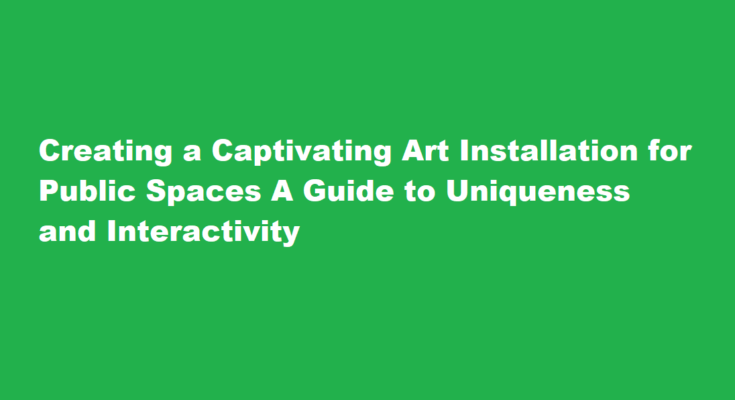Public art installations have the power to engage and inspire communities, transforming ordinary spaces into vibrant hubs of creativity and expression. Building a unique and interactive art installation for a public space requires careful planning, innovative thinking, and an understanding of the environment’s dynamics. In this article, we will explore the essential steps to create a captivating art installation that leaves a lasting impact on its audience.
Conceptualization and Purpose
The foundation of any successful art installation is a well-defined concept and purpose. Start by considering the essence of the public space and its surrounding community. Ask yourself: What message or emotion do you want to convey? How will your art contribute to the community’s identity and engagement? Is there a specific theme or story that can be integrated into the design?
Site-Specific Design
A distinctive and interactive art installation should complement its surroundings while also standing out. Embrace the unique features of the site, such as architecture, natural elements, or historical context, to tailor your design accordingly. Integrating the installation into the existing environment will foster a stronger connection with the audience and evoke a sense of belonging.
Collaboration with Artists and Experts
To bring your vision to life, collaborate with talented artists and experts who can provide valuable insights and skills. Engage with local artists or art collectives to incorporate a touch of authenticity and cultural relevance into the installation. Also, consult with architects, engineers, and technology experts to ensure the practical feasibility of your design.
Interactivity and Engagement
Interactivity is a powerful tool to captivate the audience and make the art installation memorable. Consider incorporating elements that respond to human interactions, such as touch, sound, or motion sensors. Augmented reality and virtual reality can also add an immersive dimension to the experience, encouraging visitors to actively participate in the artwork.
Sustainability and Safety
Art installations in public spaces should be built with sustainability and safety in mind. Opt for eco-friendly materials, renewable energy sources, and low-impact construction techniques. Regular maintenance and safety checks are crucial to ensure the installation remains visually appealing and hazard-free throughout its lifespan.
Funding and Permissions
Art installations often require significant financial support. Explore funding opportunities from governmental grants, art foundations, corporate sponsorships, and community fundraising campaigns. Be prepared to justify the installation’s relevance and potential impact when applying for grants. Additionally, obtain the necessary permits and permissions from local authorities to execute your project legally.
Community Engagement
Involving the community in the creation process fosters a sense of ownership and pride. Organize workshops, public consultations, or collaborative events where residents can contribute ideas and feedback. By listening to the community’s aspirations, the art installation will resonate better with its audience and reflect their identity.
Trial and Testing
Before the final installation, conduct small-scale trials and tests to ensure the interactivity and functionality of the artwork. Identify potential issues and gather feedback from participants to make necessary adjustments. This iterative process will help refine the installation and ensure a smooth unveiling.
Documentation and Promotion
Document the creation journey through photographs, videos, and behind-the-scenes stories. This documentation can be valuable for future exhibitions, promotional materials, and grants applications. Create a marketing plan to promote the installation through social media, press releases, and local events, generating anticipation and curiosity among the community.
Unveiling and Celebration
Finally, the day arrives for the grand unveiling of your unique and interactive art installation. Organize a celebratory event that invites the community to experience the artwork firsthand. Provide opportunities for visitors to share their thoughts and feelings about the installation, fostering a sense of connection and dialogue.
FREQUENTLY ASKED QUESTIONS
What makes installation art unique?
What makes installation art different from sculpture or other traditional art forms is that it is a complete unified experience, rather than a display of separate, individual artworks.
What is an interactive art installation?
Interactive art is a form of art that involves the spectator in a way that allows the art to achieve its purpose. Some interactive art installations achieve this by letting the observer walk through, over or around them; others ask the artist or the spectators to become part of the artwork in some way.
In conclusion, building a unique and interactive art installation for a public space requires a blend of creativity, community engagement, and technical expertise. By conceptualizing a purposeful design, embracing the site’s characteristics, and prioritizing interactivity, your art installation will become a cherished part of the community’s identity and a source of inspiration for years to come.
Read Also : Planning a Transformative Volunteer Event Benefiting the Community and the Environment



